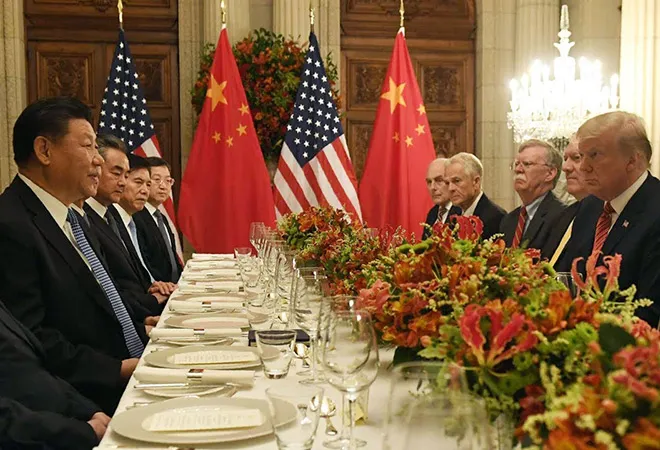-
CENTRES
Progammes & Centres
Location
Beijing's expanding footprint in this oil-rich region has set the stage for a competition with Washington

In more ways than one, the year gone by was annus horribilis for the Chinese Communist Party and its leader, Xi Jinping. From declining economic growth and a Belt and Road Initiative debacle to troubles in Hong Kong and Xinjiang, there were multiple fires that had to be doused. The Donald Trump Administration changed not only the American approach towards China but also the wider Western approach towards the country, by asking for a balanced relationship, using unrelenting economic pressure.
However, the first phase of a trade deal, which had finally been agreed to by Washington and Beijing in December last year, was signed on January 15. It commits China to buying $200 billion more in US farm products and other goods and services over two years than it did in 2017, before the trade war erupted. Yet, it leaves in place many tariffs in an attempt to continue to limit the supply of Chinese goods to the US market.
Earlier, just when Beijing would have thought it could not get any worse for it, Mr Trump gave China a New Year gift by escalating a crisis in West Asia by giving orders to target the head of the Revolutionary Guard’s elite Quds Force, Qassem Soleimani. This resulted in the most significant confrontation between the US and Iran in recent years, dramatically heightening tensions in a region already beset with multiple fault lines.
In an election year in America, Mr Trump would have made China a focus of his foreign policy achievements, given that he has pushed his rivals also to acknowledge problems in the traditional American approach towards Beijing. A broader debate on China would also entail a focus on America’s changing regional priorities in the Indo-Pacific.
Compared to Barack Obama’s pivot to Asia, Mr Trump’s concept of a free and open Indo-Pacific has held greater promise, even though a concrete policy approach hasn’t fully materialised. But now, after the renewed turbulence in West Asia, America will have to focus greater attention on the region. This will once again give breathing space to China, which has continued to expand its military and economic profile in the Indo-Pacific.
Even in West Asia, where America is struggling to retain its relevance, China's footprint has been expanding. And unlike the US, it has so far managed to be on good terms with not only Iran but also the Arab Gulf states and Israel. China is not only among the top three defence partners for Iran and its largest trading partner, but it has also been expanding the scope of its bilateral engagement with Tehran. This resulted in China-Iran-Russia joint naval exercises near the strategically vital Strait of Hormuz in the Indian Ocean last month. China has provided the shield which has allowed Iran to continue to develop its defence capabilities despite global sanctions.Beijing was quick to condemn the “military adventurist act by the US”, which “goes against basic norms governing international relations and will aggravate tensions and turbulence in the region” even as Tehran hoped China could “play an important role in preventing escalation of regional tensions.” But Beijing has shown only limited appetite so far in taking on the US directly, apart from defending the Iranian nuclear deal and criticising American unilateralism.
In fact, it has reduced its import of Iranian oil dramatically after the ending of US sanctions waivers last year. China was Iran’s biggest oil buyer prior to US sanctions, but after that despite Iran’s attempt to convince China to continue trading with Iran, there has been reluctance on the part of Beijing to violate the sanctions regime. The payment for Iranian oil is also geared towards paying Iranian debts to Chinese companies that had invested in Iran’s oil and gas sector.
The US has maintained its primacy in West Asia for the last several decades and the Carter Doctrine, enunciated by former US President Jimmy Carter in 1980, explicitly committed Washington to defend the oil fields of the Persian Gulf against external threats. Despite signals that Mr Trump might be going back on this decades-old doctrine, he has once again brought the debate on America’s regional role to centre stage. And with China’s rise in the region, the stage might be set for a regional competition between the two. Against the backdrop of America’s recent actions, China’s power and influence in West Asia is likely to grow as it seeks greater responsibility for securing its regional interests.
Yet, there is no evidence so far that China wants to take on America’s role in West Asia. In fact, it would like to make sure that despite its rhetoric, it treads lightly in the region, especially as this moment presents another opportunity for Beijing to strengthen its power infrastructure, which has been growing weak over the past few years. Wars in West Asia have sapped American power while emboldening China in the past. Beijing will be hoping that history might once again repeat itself.
This commentary originally appeared in Business Standard.
The views expressed above belong to the author(s). ORF research and analyses now available on Telegram! Click here to access our curated content — blogs, longforms and interviews.

Professor Harsh V. Pant is Vice President – Studies and Foreign Policy at Observer Research Foundation, New Delhi. He is a Professor of International Relations ...
Read More +